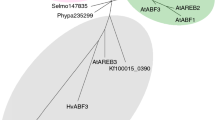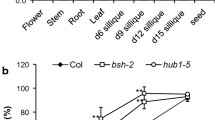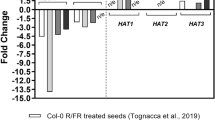Abstract
Seed dormancy is an important developmental process that prevents pre-harvest sprouting in many grains and other seeds. Abscisic acid (ABA), a plant hormone, plays a crucial role in regulating dormancy but the underlying molecular regulatory mechanisms are not fully understood. An Arabidopsis zinc-finger gene, MEDIATOR OF ABA-REGULATED DORMANCY 1(MARD1) was identified and functionally analyzed. MARD1expression is up-regulated by ABA. A T-DNA insertion in the promoter region downstream of two ABA-responsive elements (ABREs) renders MARD1unable to respond to ABA. The mard1 seeds are less dormant and germinate in total darkness; their germination is resistant to external ABA at the stage of radicle protrusion. These results suggest that this novel zinc-finger protein with a proline-rich N-terminus is an important downstream component of the ABA signaling pathway that mediates ABA-regulated seed dormancy in Arabidopsis.
Similar content being viewed by others
References
Baskin, C.C. and Baskin, J.M. 1998. Seeds: Ecology, Biogeography, and Evolution of Dormancy and Germination. Academic Press, San Diego, CA.
Choi, H., Hong, J., Ha, J., Kang, J. and Kim, S.Y. 2000. ABFs, a family of ABA-responsive element binding factors. J. Biol. Chem. 275: 1723–1730.
de Bruxelles, G.L., Peacock, W.J., Dennis, E.S. and Dolferus, R. 1996. Abscisic acid induces the alcohol dehydrogenase gene in Arabidopsis. Plant Physiol. 111: 381–391.
Debeaujon, I. and Koornneef, M. 2000. Gibberellin requirement for Arabidopsis seed germination is determined both by testa characteristics and embryonic abscisic acid. Plant Physiol. 122: 415–424.
Ezcurra, I., Wycliffe, P., Nehlin, L., Ellerstrom, M. and Rask, L. 2000. Transactivation of the Brassica napus napin promoter by ABI3 requires interaction of the conserved B2 and B3 domains of ABI3 with different cis-elements: B2 mediates activation through an ABRE, whereas B3 interacts with an RY/G-box. Plant J. 24: 57–66.
Finkelstein, R.R. and Lynch, T.J. 2000a. Abscisic acid inhibition of radicle emergence but not seedling growth is suppressed by sugars. Plant Physiol. 122: 1179–1186.
Finkelstein, R.R. and Lynch, T.J. 2000b. The Arabidopsis abscisic acid response gene ABI5 encodes a basic leucine zipper transcription factor. Plant Cell 12: 599–609.
Finkelstein, R.R., Gampala, S.S. and Rock, C.D. 2002. Abscisic acid signaling in seeds and seedlings. Plant Cell 14(Suppl.) S15–45.
Giraudat, J., Hauge, B.M., Valon, C., Smalle, J., Parcy, F. and Goodman, H.M. 1992. Isolation of the Arabidopsis ABI3 gene by positional cloning. Plant Cell 4: 1251–1261.
Goldberg, R.B., de Paiva, G. and Yadegari, R. 1994. Plant embryogenesis: zygote to seed. Science 266: 605–614.
Guiltinan, M.J., Marcotte, W.R. Jr. and Quatrano, R.S. 1990. A plant leucine zipper protein that recognizes an abscisic acid response element. Science 250: 267–271.
Hajdukiewicz, P., Svab, Z. and Maliga, P. 1994. The small, versatile pPZP family of Agrobacterium binary vectors for plant transformation. Plant Mol. Biol. 25: 989–994.
He, Y. and Gan, S. 2001. Identical promoter elements are involved in regulation of the OPR1 gene by senescence and jasmonic acid in Arabidopsis. Plant Mol. Biol. 47: 595–605.
He, Y., Tang, W., Swain, J.D., Green, A.L., Jack, T.P. and Gan, S. 2001. Networking senescence-regulating pathways by using Arabidopsis enhancer trap lines. Plant Physiol. 126: 707–716.
Higo, K., Ugawa, Y., Iwamoto, M. and Korenaga, T. 1999. Plant cis-acting regulatory DNA elements (PLACE) database: 1999. Nucl. Acids Res. 27: 297–300.
Hoth, S., Morgante, M., Sanchez, J.P., Hanafey, M.K., Tingey, S.V. and Chua, N.H. 2002. Genome-wide gene expression profiling in Arabidopsis thaliana reveals new targets of abscisic acid and largely impaired gene regulation in the abi1-1 mutant. J. Cell Sci. 115: 4891–4900.
Hugouvieux, V., Kwak, J.M. and Schroeder, J.I. 2001. An mRNA cap binding protein, ABH1, modulates early abscisic acid signal transduction in Arabidopsis. Cell 106: 477–487.
Iwasaki, T., Yamaguchi-Shinozaki, K. and Shinozaki, K. 1995. Identification of a cis-regulatory region of a gene in Arabidopsis thaliana whose induction by dehydration is mediated by abscisic acid and requires protein synthesis. Mol. Gen. Genet. 247: 391–398.
Karssen, C., Zagorski, S., Kepczynski, J. and Groot, S. 1989. Key role for endogenous gibberellins in the control of seed germination. Ann. Bot. 63: 71–80.
Kim, S.Y., Chung, H.J. and Thomas, T.L. 1997. Isolation of a novel class of bZIP transcription factors that interact with ABA-responsive and embryo-specification elements in the Dc3 promoter using a modified yeast one-hybrid system. Plant J. 11: 1237–1251.
Kim, K.N., Cheong, Y.H., Grant, J.J., Pandey, G.K. and Luan, S. 2003. CIPK3, a calcium sensor-associated protein kinase that regulates abscisic acid and cold signal transduction in Arabidopsis. Plant Cell 15: 411–423.
Koornneef, M., Jorna, M.L., Brinkhorst-van der Swan, D.L.C. and Karssen, C.M. 1982. The isolation of abscisic acid (ABA) deficient mutants by selection of induced revertants in non-germinating gibbrellin sensitive lines of Arabidopsis thaliana (L.) Heynh. Theor. Appl. Genet. 61: 385–393.
Koornneef, M., Reuling, G. and Karssen, C. 1984. The isolation and characterization of abscisic acid-insensitive mutants of Arabidopsis thaliana. Physiol. Plant. 61: 377–383.
Koornneef, M., Bentsink, L. and Hilhorst, H. 2002. Seed dormancy and germination. Curr. Opin. Plant Biol. 5: 33–36.
Leon-Kloosterziel, K.M., Gil, M.A., Ruijs, G.J., Jacobsen, S.E., Olszewski, N.E., Schwartz, S.H., Zeevaart, J.A. and Koornneef, M. 1996. Isolation and characterization of abscisic acid-deficient Arabidopsis mutants at two new loci. Plant J. 10: 655–661.
Leung, J. and Giraudat, J. 1998. Abscisic acid signal transduction. Annu. Rev. Plant Physiol. Plant Mol. Biol. 49: 199–222.
Leung, J., Merlot, S. and Giraudat, J. 1997. The Arabidopsis ABSCISIC ACID-INSENSITIVE2 (ABI2) and ABI1 genes encode homologous protein phosphatases 2C involved in abscisic acid signal transduction. Plant Cell 9: 759–771.
Mackay, J.P. and Crossley, M. 1998. Zinc fingers are sticking together. Trends Biochem. Sci. 23: 1–4.
Papi, M., Sabatini, S., Bouchez, D., Camilleri, C., Costantino, P. and Vittorioso, P. 2000. Identification and disruption of an Arabidopsis zinc finger gene controlling seed germination. Gen. Dev. 14: 28–33.
Petit, M.M., Meulemans, S.M. and van de Ven, W.J. 2003. The focal adhesion and nuclear targeting capacity of the LIM-containing lipoma-preferred partner (LPP) protein. J. Biol. Chem. 278: 2157–2168.
Pla, M., Vilardell, J., Guiltinan, M.J., Marcotte, W.R., Niogret, M.F., Quatrano, R.S. and Pages, M. 1993. The cis-regulatory element CCACGTGG is involved in ABA and water-stress responses of the maize gene rab28. Plant Mol. Biol. 21: 259–266.
Raz, V., Bergervoet, J.H. and Koornneef, M. 2001. Sequential steps for developmental arrest in Arabidopsis seeds. Development 128: 243–252.
Sambrook, J. and Russell, D.W. 2001. Molecular Cloning: A Laboratory Manual. Cold Spring Harbor Laboratory Press, Plainview, NY.
Shen, Q., Zhang, P. and Ho, T.H. 1996. Modular nature of abscisic acid (ABA) response complexes: composite promoter units that are necessary and sufficient for ABA induction of gene expression in barley. Plant Cell 8: 1107–1119.
Skriver, K., Olsen, F.L., Rogers, J.C. and Mundy, J. 1991. cis-acting DNA elements responsive to gibberellin and its antagonist abscisic acid. Proc. Natl. Acad. Sci. USA 88: 7266–7270.
Toyomasu, T., Yamane, H., Murofushi, N. and Inoue, Y. 1994. Effects of exogenously applied gibberellin and red light on the endogenous levels of abscisic acid in photoblastic lettuce seeds. Plant Cell Physiol. 35: 127–129.
Vicient, C.M. and Delseny, M. 1999. Isolation of total RNA from Arabidopsis thaliana seeds. Anal. Biochem. 268: 412–413.
Xiao, S., McCarthy, J.G., Aster, J.C. and Fletcher, J.A. 2000. ZNF198-FGFR1 transforming activity depends on a novel proline-rich ZNF198 oligomerization domain. Blood 96: 699–704.
Yamaguchi, S. and Kamiya, Y. 2001. Gibberellins and light-stimulated seed germination. J. Plant Growth Regul. 20: 369–376.
Zeevaart, J.A.D. and Creelman, R.A. 1988. Metabolism and physiology of abscisic acid. Annu. Rev. Plant Physiol. Plant Mol. Biol. 39: 439–473.
Author information
Authors and Affiliations
Rights and permissions
About this article
Cite this article
He, Y., Gan, S. A novel zinc-finger protein with a proline-rich domain mediates ABA-regulated seed dormancy in Arabidopsis . Plant Mol Biol 54, 1–9 (2004). https://doi.org/10.1023/B:PLAN.0000028730.10834.e3
Issue Date:
DOI: https://doi.org/10.1023/B:PLAN.0000028730.10834.e3




